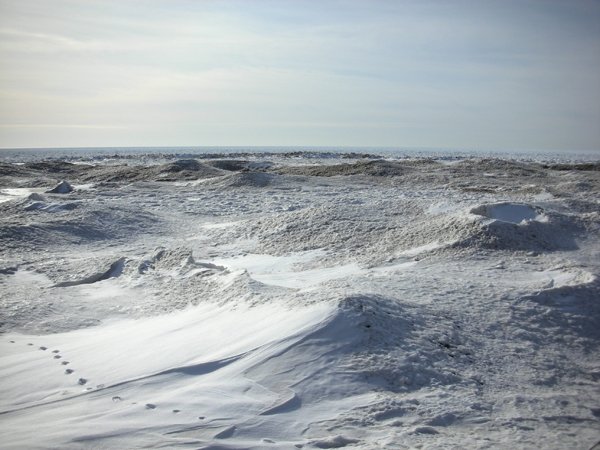Watertown, NY, January 19, 2012 - This year's lack of snow could make it tricky for those who regulate water levels on Lake Ontario and the St. Lawrence River.
As New York Sea Grant's Recreation/Tourism Specialist Dave White tells the newscasters at Watertown's WWNY-TV 7 News This Morning studios, low amounts of snow could mean low water levels for the coming year, depending on if snow finally comes and the amount of rain we get in the spring. White also explains how regulators try to balance the needs of recreation, commerce and the environment.
"The St. Lawrence Border Control are looking at the fact that we don't have any snow pack," says White. "Usually up in the Tug Hill, up in the mountains, up in the major areas of the drainage basin that come into Lake Ontario and the St. Lawrence River, there's a solid snow pack - 100 to 150 inches. We don't have that, so now they're looking at the system and asking, 'What's going to happen if we don't get that major snow pack?' That way, they can continue to manage the system, putting those models into place. And, again, their focus is to maintain the system for all of the various users who are out there, including maintaining it for recreation, commerce, shoreline protection throughout the entire summer."
White adds that the St. Lawrence Border Control have to look at the issue now so that, if they need to, they can decide to hold water back or let it flow. "They do this because they then have to put into balance if we don't have a snow pack but then we get major rains that they maintain water levels and avoid any flooding issues."
So, what is the outlook for 2012 as we head into the spring? "In trying to maintain the system, the Border Control are waiting for it to get cold enough, because one of the major issues they have to look at is getting a good solid ice pack on the St. Lawrence River." He adds, "This is the time of year that people need to look at these issues and continue to be aware of them. Whenever anyone is dealing with lake levels or any of the other recreation issues, there's a need to look ahead three to six months. So, now is not the time to sit back. Being engaged in the discussion and being aware of what is going on is crucial so that concerns can be share with those who are helping to manage the system."

Ice covering Lake Ontario in February 2009, something that has yet to occur this winter season. As NYSG's Dave White points out, this has the St. Lawrence Border Control and others concerned about water levels into the spring and beyond.
Photo by Paul C. Focazio, NYSG.
White also touches upon a pressing matter involving the International Joint Commission.
It's been more than a decade since the IJC conducted a study to come up with a new plan for water levels on Lake Ontario and the St. Lawrence River. "There's already a lot of discussion and Congressional interest on the plan and it hasn't even been released to the public yet," says White. The IJC is expected to host public hearings on the plan in the early part of spring.
Since April 2006, White has been bringing Sea Grant's "message" to the morning masses at WWNY TV 7, a Fox affiliate in downtown Watertown, during one of the highest rated TV blocks in the "wake-up hours," the 6:30-7 am stretch.
Sea Grant's 'five minutes of fame' - which potentially reaches around 10,000 viewers in New York's Jefferson and Northern Oswego Counties - has featured topics over the years such as boating safety, aquatic invasive species, diving in search of sunken wrecks, the dune and Salmon River stewards program, shoreline land issues, tourism, and marine safety.